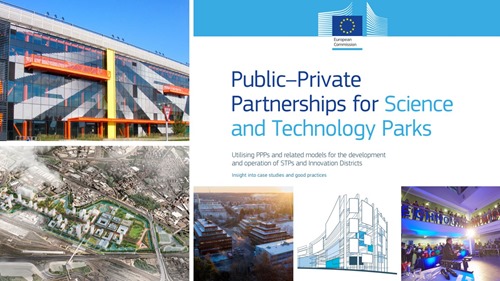New European Commission report Public–Private Partnerships for Science and Technology Parks
/Public_private_partnerships_for_STPs.JPG)
The Joint Research Centre (JRC), the European Commission’s science and knowledge service, recently published a report into Public–Private Partnerships (PPPs) for Science and Technology Parks. Made in collaboration with IASP and other experts, it includes contributions and case studies from IASP members in the UK, Sweden, Slovenia, the USA and Italy, as well as data from our wider community.
The study began through the distribution of an online survey among IASP members, which collected information on science parks and areas of innovation/innovation districts operating through three main models of Public/Private cooperation: (1) Long-term partnership involving a degree of risk sharing (the closest to a traditional PPP); (2) Jump-in model where private investors are involved at a later stage of a project’s development; or (3) Management Partnership.
Public–Private Partnerships have been widely applied as credible models for the development and operation of public infrastructure. Through private sector involvement, the public sector manages to better control costs and debt levels and, in return, offers to the private sector access to new long-term investment opportunities. For PPPs to be successful, proper identification and management of risks are pivotal and reward mechanisms need to be carefully constructed to allow both sides to play to their respective strengths, benefit from the deal and extract value from it.
This study aims to provide answers to two key questions: how to apply PPPs to the development and sustainable operation of STPs and AOIs/innovation districts, and identify the key features of currently existing PPPs.
It contains detailed case studies based on in-depth interviews with IASP members Gavin Poole and Mike Magan at Here East (UK); Mats Bergh at Johanneberg Science Park (Sweden); Jernej Pintar at Technology Park Ljubljana (Slovenia); Paul Krutko at Ann Arbor SPARK (USA), and the developers of MIND – Milan Innovation District (Italy), as well as Carolina Benjaminsen at Orestad Innovation City Copenhagen (Denmark), Roderick Barker at Technology Park Brno (Czech Republic) and Uzy Zwebner at Gav-Yam Negev Advanced Technologies Park (Israel).
/)


/canvascolor(0xffffffff)/sztip_logo_allo_1.png)
/canvascolor(0xffffffff)/MemberLogo-66701-317301.png)
/canvascolor(0xffffffff)/ppnt_logo_EN.png)
/canvascolor(0xffffffff)/2019_09_12_Argentina_Buenos_Aires_Innovation_P.png)
/canvascolor(0xffffffff)/logotecnopole_alta_resolucion_1.jpg)
/canvascolor(0xffffffff)/JOIST_Innovation_Park_Logo_-_White_1.png)
/canvascolor(0xffffffff)/sip_zurich_rgb_transparent_1.png)
/canvascolor(0xffffffff)/Cyan_horizontal.png)
/canvascolor(0xffffffff)/2024_04_04_The_Netherlands_Lindholmen_Science_Park.jpg)
/canvascolor(0xffffffff)/Logo_ITP-01_1.jpg)
/canvascolor(0xffffffff)/MemberLogo-68701-6096.jpg)
/canvascolor(0xffffffff)/MemberLogo-43801-157601.jpg)
/canvascolor(0xffffffff)/VUTSouthernGauteng.png)
/canvascolor(0xffffffff)/logo_TROKUT_Å_ibenik_PNG_2.png)
/canvascolor(0xffffffff)/2017_06_19_South_Africa_The_Innovation_Hub.emf.jpg)
/canvascolor(0xffffffff)/2017_08_04_fundecyt-pctex-h.png)
/canvascolor(0xffffffff)/2017_11_17_Taiwan_Southern_Taiwan_SP.png)
/canvascolor(0xffffffff)/logo_46.png)
/canvascolor(0xffffffff)/PCT_VILLA_CLARA.png)
/canvascolor(0xffffffff)/2019_11_12_China_Tuspark_(Jiangsu).png)
/canvascolor(0xffffffff)/Logo_biopark_200x200_3.jpg)
/canvascolor(0xffffffff)/2024_04_24_UK_UNIP.jpg)
/canvascolor(0xffffffff)/MemberLogo-75801-6122.jpg)
/canvascolor(0xffffffff)/2018_08_14_Qatar_Qatar_Science_Park.jpg)
/canvascolor(0xffffffff)/MemberLogo-87901-361401.png)
